
When New Afton, Canada’s only block cave mine, reaches full production, it will probably be the country’s largest underground mine on a tonnage basis.
New Gold’s New Afton Reaches Commercial Production
A team of seasoned professionals builds the next great block cave operation
By Steve Fiscor, Editor-in-Chief

Located about 10 km from Kamloops in south central British Columbia, the New Afton mine, which officially began production during June 2012, looks nothing like the old Afton mine. The Afton mine was originally operated by Teck Cominco as an open-pit copper-gold mine. The old pit has been essen-tially drained and dewatered.
Administrative offices, training facil-ities and the dry are currently housed in modular containerized facilities. The footprint of disturbed land on the sur-face is much smaller. The underground mine has stockpiled more than 1 mil-lion tons of ore on the ground. A new concentrator and tailings storage facili-ty has been constructed.
Over the course of its current mine life (12 years), the New Afton mine is expected to produce on average, 85,000 oz/y of gold and 75 million lb/y of copper. It’s the only block cave oper-ation currently operating in Canada and, once it reaches its full capacity of 11,000 metric tons per day (mt/d), it will probably be the largest under-ground mine on a tonnage basis (4 mil-lion mt/y). As of August, the mine had officially reached the commercial pro-duction stage, which they define as 60% of nameplate capacity for 30 days, or 6,600 mt/d.
New Gold has assembled a team with extensive underground production expe-rience in general and block caving expertise in particular. The engineers and managers bring experience from other block cave mines, such as Freeport’s Grasberg (Indonesia) and Henderson (Colorado) operations, and Magma Copper (Arizona). They are quick to point to what they learned and how they have improved the mine design at New Afton. Starting with a blank slate, they are ushering in a new era for underground mining. They are implementing all of the modern technol-ogy at their disposal, such as automated drilling and blasthole loading, software for cave management and draw control, etc. At the same time, New Afton has also commenced a program to recruit and train a new generation of miners.
Developing the Ore Body
A deep mineralized ore zone, which is a
finely disseminated copper sulphide
(chalcopyrite), lies west of the old Afton
pit at a depth of 600 m. The bulk of the
deposit covers a maximum footprint of a 900-m long by approximately 125 m
wide spanning a vertical distance of
approximately 350 m.
The five main underground levels— the apex, undercut, extraction, ventila-tion and haulage levels—can be accessed by two ramps from the sur-face. Six raises have been developed for ventilation. The undercut level creates the void for the cave. Miners drill up-holes in a fan pattern to blast the rock above the undercut level. “We do not muck out all of the material, just enough to create a void for the next blast,” said Eric Strom, technical serv-ices superintendent for New Afton. “Directly below this level, we create draw points in a bell shape.”
The design of the extraction level is similar to Codelco’s El Teniente mine with draw points in a straight line rather than the traditional crescent-shaped (herringbone) method. Each of the strike drive accesses has a letter desig-nation (B thru G, no A). On the drawbell card, for example, C6N means the miner would be working on C strike drive accessing the 6 bell line on the north side. The miners use LHDs to carry ore from drawbells to ore passes that connect to the haulage level. Trucks then haul the ore to a primary crushing installation. The ore is reduced to a manageable size and loaded onto a 4.5-km long conveyor network and transported to the surface.


Caving activity is determined by the failure zone or the hydraulic radius. “In an effort to manage the cave, we will place a lot of effort on draw control,” Strom said. “We will pull from these draw points in an organized fashion to balance the draw.” Ore is initially pulled from the northwest corner of the extraction level and it gradually shifts across the entire ore body footprint from west to east toward the old pit.
On the surface, drilling crews are preparing to dewater the eastern por-tion of the ore body below the old pit. The lake in the pit was quite high at one time. The mine maintains a very conservative buffer between the pit lake and caving area. “We are advancing toward it,” Strom said. “We have that timing in mind as we build the dewatering project.”
Most of the water has been pumped down. “We now know the depth of fines that remain,” Strom said. “We have surveyed and cored it with Mud Bay Drilling. A portion of fines will be removed by slurry pumping. Then we will be down to material that we know can be adequately dewatered. The drill pad has been completed and we are installing dewatering wells.” New Afton is a zero discharge site and all of the water has been pumped to the tailings storage facility and recycled through the system.
One of the features that sets the New Afton block cave design apart from others is the apex level. “Typically a block cave does not have an apex level, but we have opted to develop this level to act as an inspection level,” said Bob Tolden, technical services superintend-ent for New Afton. “We can assess the ground movement within the cave. If necessary, we could remediate from that area.”
The long-hole drilling extends from the undercut level to the apex level, Strom explained. “If a long-hole blast fails, it’s usually the toes that hold back,” Strom said. “The apex level allows us to make sure that we have broken the entire undercut open and we can start the cave evenly.”
The mine blasts the drawbell in one shot. Using a Machines Roger (pro-nounced ro-jay), a 30-in. slot is bored to about 2 m below the undercut level. Another set of holes are drilled and blasted into the free face created by the 30-in. slot. By shooting the drawbell in one blast, the miners do not have to re-enter the brow area. At the end of June, a total of 29 drawbells had been blast-ed. “We blasted 21 this year, working at a rate of four bells per month,” Tolden said. “We started slowly, but we are get-ting better with time.”
The drawbells can be accessed from both sides. Knowing they will be used for a long period of time, the mine pro-vides extra support for the drawpoints. A concrete floor is poured and steel sets are placed at the brow for extra support. “We will pull hundreds of thousands of tons from one drawpoint, which equates to millions of dollars in revenue from that location, so we really reinforce those areas,” said Strom.
New Afton uses an overdrawn venti-lation system that sweeps over the pro-duction areas to exhaust raises, which pulls air down to the ventilation level and then out through dedicated exhaust raises to the surface through the fans. “We have a push-pull system that over-draws the production area once,” Strom said. “That dust goes directly to exhaust. All of the fans are set to intake now. When the last of the vent raises are completed, we will pick up those fans and turn them around.” The final configuration will have three intakes and three exhaust fans.
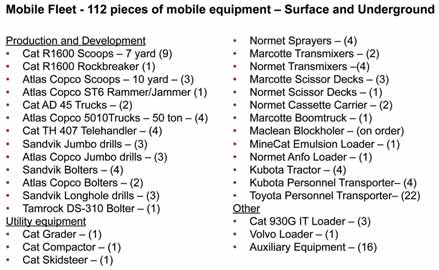
The mine has also constructed an impressive refuge chamber as far as design and use. It is located at the foot-wall strike drive near the maintenance shop on the extraction level where much of the activity will be taking place. The chamber is used regularly. It has an office and a large screen LCD television above a lunch room with microwaves. “In the event of an emer-gency, we would move to the secondary support systems,” Strom said. “If for some reason mine air fails, we have a MineARC CO2 scrubber and oxygen bot-tles. The back-up power system will support 60 people for 36 hours. If the system has to be used longer than 36 hours, a tertiary plan makes use of a 600-m drill hole connected to the sur-face for a water line, compressed air and communication.”
Of the 1 million tons on the ground, nearly 60% was conveyed to the surface by belt. The conveyor network consists of five flights of 42-in. steel cord belting (ST 3400) with twin 600-hp motors powering head-pulley drives. The third flight is the longest conveyor, traversing 1.2 km up a 16.6% grade to surface. The belt has been engineered so the bot-tom belt turns over to prevent spillage. Industrial Equipment Manufacturing (IEM), a Vancouver-based firm, designed all of the transfer stations.
Prior to the conveyor installation, ore was trucked to the surface. “The conveyor system has made a huge dif-ference,” Tolden said. “As far as drift-ing, in April the entire operation had a record month of 955 m. We just recent-ly completed the gyratory crusher chamber and the CTC 4-5, a conveyor transfer center.”
The mine also recently completed a 600-m slickline, moving the trans-mixer traffic off the ramp, which transported the concrete from the surface. It deliv-ers concrete closer to the areas where it is most needed. “We are transporting great amounts of concrete and fiber-crete for development purposes, road-ways and drawpoints,” Strom said. “The slickline now dumps concrete directly into the Normet trans-mixer trucks.”
New Afton has a total of 112 pieces of mobile equipment. Some of it is used on the surface, but most it works in production or development or sup-porting those activities. They have 12 LHDs. The 10-yd3 Atlas Copco LHDs are used on production and 7-yd3 Cat scoops are used for development. “In terms of meters, for the year, we are performing quite well,” Tolden said. “We have been transitioning from con-tractor support to in-house develop-ment. New Afton is mining at a rate of 500 m/month and Thyssen Canada is at 250 m/month. We had Cementation Mining on site, but they have now been phased out.”
The milling capacity will briefly over-take mine production this year until the mine reaches full production. “There is a period of draw down until the mine reaches 11,000 mt/d in the first quar-ter of 2013,” Tolden said. The stock pile provides a cushion until the mine gets up to full capacity.
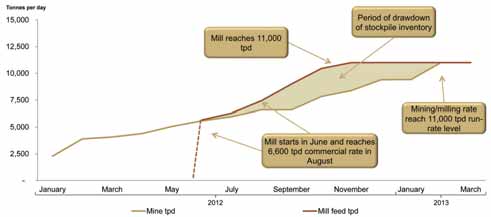
Mining in the Modern Era
“We blasted our first undercut June 29,
2011, for the starter raise,” said Kurt
Keskimaki, mine manager for New Afton. “On June 29, 2012, we had 1
million tons of ore in the stockpile. We
blasted our first bell September 8,
2011. We now have 29 bells blasted as
of June 30, 2012.”
To scale up operations that quickly, New Gold recruited and trained a lot of miners. The new recruits spent time in classrooms and on simulators before they began operating equipment under-ground. “Some of them had previous drilling experience, most had none,” Keskimaki said. “The technology on the equipment, such as the Sandvik T-Cad system on the jumbos and the long-hole drills, enable these miners to drill a very sophisticated bell with no hitches. I could not be happier with bell development at New Afton. Our undercutting and bell drilling is the best in the caving business.” That’s a significant statement, Keskimaki ex-plained, considering the ring drill did-n’t arrive on the property until February of 2011. Keskimaki cut his teeth at the Henderson mine in Colorado.
Until the gyratory crusher is installed, which will allow the mine to achieve its nameplate capacity, New Afton relies on a large jaw crusher. Once the gyratory crusher is opera-tional, the development jaw crusher will remain operational, serving as a back-up. Admiring the large 18-m high room blasted out for the gyratory crusher, Keskimaki explains that all of the min-ing was performed by New Afton min-ers, not contractors. Once it’s opera-tional, 50-mt trucks will dump from both sides into a 43 x 69 FLSmidth Fuller-Traylor gyratory crusher.
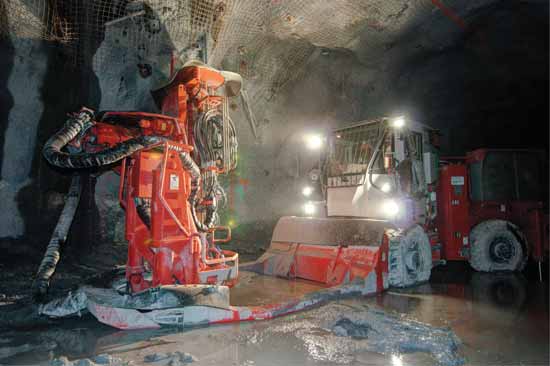
Underground inspecting the F-G ring pattern, the cave line appears to be over-supported. Usually cave lines are really ratty, Keskimaki explained, but these cave lines look good. “We pre-load a minimum of one set of rings,” Keskimaki said. “We are operating in close quarters here, so the whole pat-tern is pre-loaded. It’s illegal to have preloaded holes in British Columbia so we wrote a variance request and the Ministry of Mines approved it. This is a much safer scenario. It keeps the work-ers away from the open brow.”
New Afton uses Anfo on develop-ment and emulsion on the undercut and the drawbells. “We switched from 3- to 4-inch holes and from 45- to 51-mm steels and we are getting better fragmentation and great productivity,” Keskimaki said. “I have been in the caving business since 1976 when we started caving at Henderson and this is the best looking undercut I have seen.” A Robo Arm from Orica is used to load emulsion in the up-holes. The operator programs the depth, hole size and emul-sion loading rates. A cap is placed on the end of the hose and then the operator pushes it up the hole along with I-Kon programmable detonators. The machine automatically pumps the hole full of emulsion as the hose is retracted. “This technique is remarkable,” Keskimaki said. “I was somewhat skeptical, but on these 27 m up-holes the system works great.” New Afton owns the machine and Orica supplies the operator. Orica is responsible for running the machine and placing the emulsion in the hole.
“This is underground mining in the modern era,” Keskimaki said. “A miner sits in an air-conditioned cab on a ring drill and drills the bell perfectly and then these guys load the holes.” The crews blasting the drawbells drill a 6-in. pilot hole to the undercut level. They ream it to 10-in. Then they ream it to 30 in. with the Machines Roger. “The 30-inch slot acts as the cut in the round,” Keskimaki said. “Then we drill selective holes and blast into the cut. It’s a specific design that breaks into the undercut. We are in and out of here in three days.”
To support the drawbell, 6-m cable bolts are installed at the brow. “We shotcrete in cycle instead of after-ward,” Keskimaki said. “We pride our-selves on drawpoint support.” Steel sets are placed and the floor is poured. Additional wear plates are attached to protect the supports.
Watching the up holes drill, Keskimaki explained the Sandvik long-hole drill is one heck of a drill. “It’s accurate, reliable and quick,” Keski-maki said. The operator appeared to be in his early 30s. How much drilling experience could he have? It doesn’t matter because he can drill a bell in five shifts. Keskimaki said they are drilling 125 m to 175 m per shift.
Inside the cab, the driller checks a printed set of plans and selects the drill hole. He raises the drill string, collars the hole, sets the depth count, and then hits the start button. The machine takes over drilling a 24.3-m long, 4-in. hole, changing steels every 4 ft. The noise level inside the cab is tolerable without hearing protection.
One of the operators loading ore from the draw point with a Cat R1600 LHD and hauling it to the ore pass said that his personal best day was 199 buckets. “On a good mucking day each operator might be able to get 300 buckets in the future,” Keskimaki said. Before climb-ing back on board, the operator com-plained of ongoing construction creating traffic bottle necks. Soon he and all of the other miners will be free from con-struction headaches and able to run as much ore as they can.
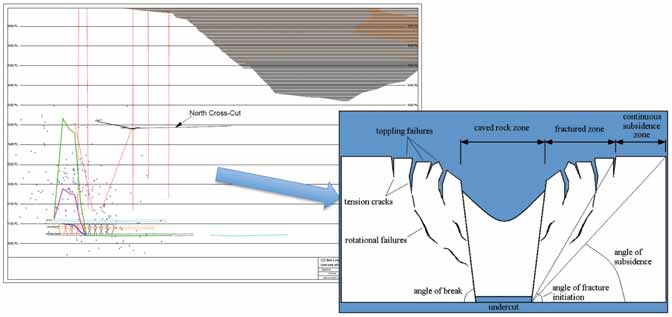
Production and Cave
Management
The engineers use a series of tools to
manage production. The mine relies
heavily on the Personal Computer Block
Caving (PCBC) software program devel-oped by Gemcom. Combining drawcone
shapes, geological models, metal prices,
and the extraction layout, it generates a
reserve estimate. “PCBC identifies the
grades we are getting from each of the
drawpoints,” Strom said. “It theoretical-ly draws the cave down and determines
what we are getting life of mine.”
By adding development constraints, NPV and drawbell construction rates, the system plots the production sequence. “We put this information in a database and it explains what we should be getting from each drawpoint,” Strom said. “To communicate that to the min-ers, we issue a shift draw card. It tells them where to go. We highlight anything of particular interest. They are told how many bucket loads are expected and the location of the dump point.” If the min-ers have problems, they can put com-ments on the card. That information is fed back into the database to determine if the draw should be increased in other areas. A convergence tracking system is also used to re-prioritize the mining sequence.
“The mine is currently in the early stages of cave development, but we are seeing evidence of caving activity from the monitoring systems that we have in place,” said Steve Kulinski, chief geol-ogist for New Afton. “The challenge is how to design for failure in the cave, while safely supporting the rest of the mine. We are using everything available to keep the areas supported as needed. Standard protocol is split sets with fiber shotcrete. We also use cable bolts, mesh straps, arches, etc.”
To measure convergence, a set of pins is installed in the back and on the ribs in a triangular pattern. “We will measure the triangle with a steel tape and calculate the strain in the pillar,” Kulinski said. “The loading situation will either increase or decrease. Each week, during the development meeting, we discuss the convergence. The PCBC engineer then updates his draw control sequence accordingly.”
The cave is going to create a void and the engineers need to know—or at least have an idea—what the failure is going to look like when it reaches the surface. To predict subsidence, the engineers track information from sever-al sources. “We have a seismic monitor-ing array set up underground,” Kulinski said. “It’s quite sensitive. We are listen-ing to the rock break. We also utilize time domain reflectometer (TDR) cables. They fail as the rock breaks. To represent the cave back two curves are generated: green (worst case) and magenta (existing conditions) above the extraction level. These curves depict where the cave back is estimated to exist at different ratios of height of draw to growth. The green is what the engi-neers design for (12:1). The magenta is 4:1. The 12:1 represents a factor of safety that’s quite conservative.”
The engineers use a number of tools on the surface to determine subsi-dence. Prisms, which can be read by a total station automatically, have been distributed around the surface. Prisms in critical areas are measured hourly, while other are measured less frequent-ly (monthly, quarterly, etc.). The mine does an annual fly over. “All of this information is fed back to the PCBC engineer,” Kulinski said. “That will tell us if we need to make adjustment in the draw to ensure the cave is perform-ing the way we want and that we are not over-stressing any pillars.”
The red stars represent seismic events. That is where the rock is start-ing to yield. Below the stars, two lines depict the cave back, between the upper line and lower line is the zone of breaking and that is where the TDR fails. The blue polygon represents the amount of intact rock removed. “The void is calculated separately, but it’s where we want it to be, between 2 and 7 m,” Strom said. “We are currently using mass balances based on PCBC data to determine how much is drawn. The difference between the two is the void that we measure and monitor. It’s an estimate drawn from all of these sources. It’s the most important part of cave management until it breaks through to the surface. We can’t wait for that day.” “It’s equally important to know that the cave doesn’t stall and that it breaks the way we want it to,” Kulinski said. “We need to have the correct amount of grade coming through the system at the right time. There are a number of ele-ments that we are trying to control through cave management."
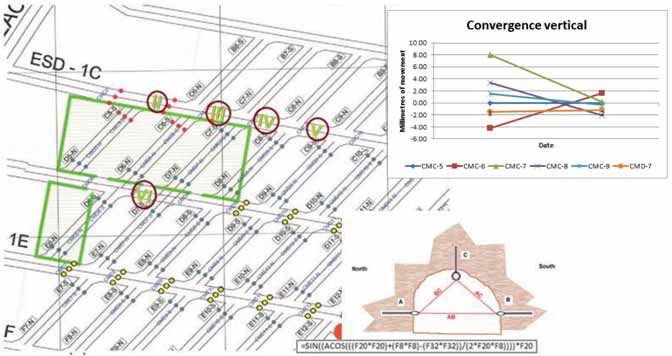

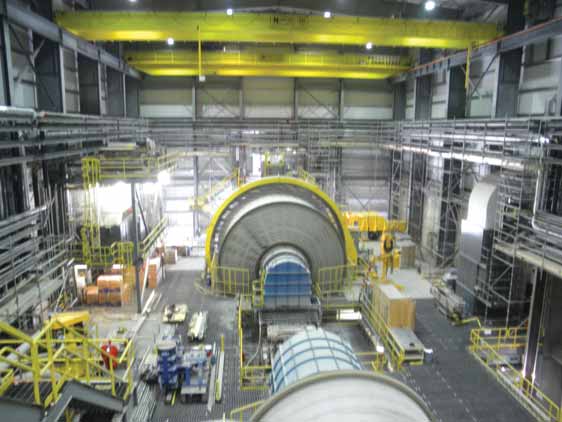
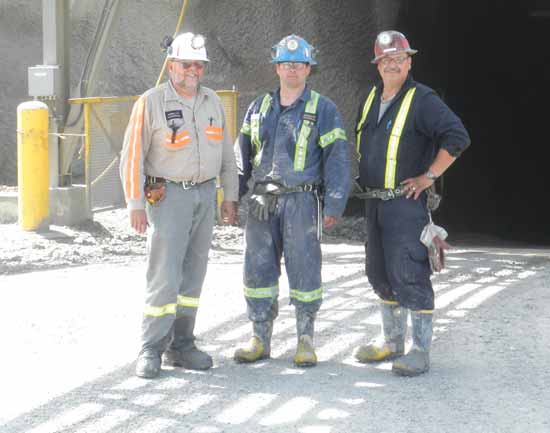
Exploration and Geology
In addition to bringing the mine and
mill online, New Afton also initiated an
underground drilling program on July 1
to define its C-zone mineral resource
located below the main reserves. Imple-menting an exploration program before
the mine is up to speed is ambitious if
not a bit unusual. Kulinski was cutting
core within a week of the mill starting,
Strom said.
Through the end of 2013, New Gold plans to invest more than $11 million to conduct 40,000 m of exploratory drilling underground. The program involves three phases, Kulinski ex-plained. “The first phase is to define the extent of B3 block. “It’s in reserve, but it’s not closed in all directions. We will also get a little infill on it. So hope-fully, we can grow that or at least define what that lower lift will look like,” he said.
The second objective is a lower lift referred to as the C zone. “We wanted further define the C zone and upgrade that resource into a reserve category,” Kulinski said. “The third phase is to define the outlier mineralization or at least probe it. One of those areas is the Deep C-zone. We have hit it with a cou-ple holes so far. That’s suggesting to us that we are not closed at depth. We have deep mineralization and we have to determine whether that will be of interest to us.”
In the cross section of the ore body, the mineralized zone appears in red. The ore-controlling faults (the Hanging wall and Foot wall faults) appear as a darker pink (left) and a darker blue (right). “All of the mineralization is pre-dominantly contained between those two faults,” Kulinski said. “It gives us a very narrow span in our footprint from a north to south perspective.”
A New Flotation Concentrator
Comes Online
The New Afton mill is designed to
process 11,000 mt/d (or 4 million mt/y)
of ore at full capacity, recovering cop-per, gold, and silver. The mill will
process a blend of primary, transition
and supergene ores using conventional
crushing, grinding, and concentration
processes. Mineral separation takes
place by gravity concentration and dif-ferential flotation. A regrinding stage
will be included in the flotation circuit.
At the time of E&MJ’s visit, the two-week old concentrator was running at
10,000 mt/d and its status was transi-tioning from construction to production.
The process begins at the stockpile on the surface, where two large apron feeders place ore (p80 6 in.) on a con-veyor that feeds the SAG mill. The SAG mill discharges minus 3-in. material onto a screen deck with 12-mm aper-tures. The oversize (p80 ½ to 3/8 in.) reports to a pebble crusher (FLSmidth Raptor). The pebble crusher product reports to the SAG mill feed.
The undersize from the screen is pumped to a bank of 26-in. Krebs hydro-cyclones. The underflow from the cyclones reports to the ball mill. “We also have the capability to split some of that feed into a flash flotation rougher and cleaner cell and another diverter to feed a gravity circuit, which consists of a 4-mm screen deck and a Knelson concentrator,” said Craig Lockhart, mill manager. “The product from flash flota-tion and the gravity circuit will flow into the final concentrate stream. The dis-charge will report to the ball mill or the ball mill discharge sump.” Lockhart worked at several copper concentrators in Arizona’s copper country.
The cyclone overflow is the flotation feed. It feeds into the rougher circuit. The rougher concentrate reports to the regrind mill, which is a 1,250-hp Veritmill. “The Vertimill is in a closed circuit with hydrocyclones,” Lockhart said. “The hydrocyclone overflow from the Vertimill circuit feeds the first cleaners. We have three stages of mechanical cleaning and also a clean-er-scavenger. What’s actually feeding the regrind mill is the rougher cons, cleaner-scavenger cons, and the second cleaner tails, that’s combined to feed the first cleaner. We use xanthate and an MIBC alcohol frother,” Lockhart said. “We also have a system for adding 3418A, which is a gold promoter.”
The final concentrate from the third cleaner goes to a high-rate thickener. It is thickened to 70% solids and reports to the filter press feed tank. The filter press removes the moisture from the thickened concentrate down to 8% to 9% moisture. The product is stored in a concentrate bin where it can be loaded into trucks.
The tailings from the rougher and the cleaner-scavenger feed into a three-stage pumping system. “The tailings are pumped directly to the tailings stor-age facility,” Lockhart said. “When we get the new cyclone plant up and run-ning, we will be segregating the fine and coarse material and using the sand product to build the dikes for the dam.”
The copper is all sulphide. “Re-covery rates are running between 80% and 90%,” Lockhart said. “Our con grade has been as low as 20% and as high as 29%.” The 10,000 mt/d rate is significant because the cone crusher is not operational yet.
Lockhart has invested four years on this project and said that construction and commissioning went surprisingly well. “We had remarkably few techni-cal problems,” Lockhart said. “Those that we have encountered have been relatively minor. We’re excited to see the 90% level.” Looking toward the future, Lockhart expects to reach full utilization soon and then start looking at optimization.
Building a Workforce
from Scratch
New Gold opened New Afton with prob-ably 20 to 25 trained miners. The expe-rienced workforce then grew to 40
trained miners. Today, the mine
employs 160 miners and 120 have
been trained on site. “We took good
people and placed them in various
training positions,” Keskimaki said.
“We brought in 15 new cohorts at a
time. We enrolled them in a three week
training program at Thompson Rivers University, in Kamloops, and they
would get training in a classroom. Prior
to stepping onto an actual piece of
equipment, the new recruits spent time
on Sandvik and Cat simulators.”
After the classroom training was com-pleted, they brought the new recruits underground for familiarization. Four of the experienced miners that were good communicators were asked to serve as mine trainers. The skills included: drilling (jumbo and bolter), shotcrete/ concrete work, and haulage (scoops and trucks). “Taking four key miners away from a pool of 50 seemed like a hard-ship, but we needed to get more miners trained up quickly,” Keskimaki said. “It was a real successful program.”
Keskimaki also relied on support from key vendors. “Sandvik has had someone on site the entire time either training the miners on operations or maintenance,” Keskimaki said.
Canadians have developed several cooperative methods to work with First Nations people (aboriginal bands). New Gold partnered locally with BC Aboriginal Mine Training Association (BCAMTA). “They helped qualify First Nations personnel to work for us,” Keskimaki said. “They would make hir-ing recommendations.” The mine employs a workforce that consists of 25% First Nations employees.
Externally, New Afton purchases aggregate for concrete from a company owned by First Nations people who operate a nearby quarry.
The mine uses a screening program to find the best candidates. “We use aptitude testing to find out who works best together who does not,” Keskimaki said. “We look for intelligent, problem-solvers that are willing to work. Overall, we have a great workforce. In a three-year period, I have seen guys go from zero experience to shift boss.
A prime example is Clint Gill, who started with no experience. Four years ago he was working as a meat cutter and today he is a cave crew shifter. Positive attitude, eager to learn, he has been promoted from a development miner to a production supervisor, Keskimaki explained. “We take good people and turn them into miners,” Keskimaki said. “We train them and expect them to do well, and a lot of them exceed our expectations. If you have smart people you can train them, especially with the smart gear we have like those Sandvik drills.”
New Gold decided to build its New Afton workforce instead of relying on contractors. “Contractors are expensive and you have to pay a per diem to import them from Ontario or wherever,” Keskimaki said. “We have a project that’s on schedule with 80% non-expe-rienced miners. It just goes to show, that if you hire the right people you can do a very good job. I can’t speak highly enough of the skilled trades that are available in British Columbia.
“I was a little bit concerned about the sophisticated drills, the T-Cad jumbo and the long-hole drills, that we purchased from Sandvik,” Keskimaki said. “Frankly, they allow us to drill a complicated bell and pull it with inex-perienced drillers. The younger miners approach automated drilling with an open mind.”
The advantage of the T-Cad system is clear, Keskimaki said, the holes end up where they need to go. “The real advan-tage is that the guys do not need to be experienced drillers,” Keskimaki said.
Similar to the mine, only about 20% of the employees come from a milling background. Half of them are already in supervisory roles, Lockhart explained. “Our staff is relatively green,” Lockhart said. “We hired them in January and put them through a six week training course. They also toured several mills. We had them running a pilot plant at the G&T Lab in Kamloops.” G&T Metallurgical Services, which is owned by ALS Chemex, is an internationally recognized metallurgical lab.
“We developed the program our-selves,” Lockhart said. “We hired a semi-retired Metso consultant. We also used elements of Ontario’s Common Core training for safety and process fundamentals. They learned the pro-cess. We wanted people to be able to think through the problems and make good decisions.
According to Keskimaki, there have been some growing pains, but New Afton’s safety record speaks volumes. So far they have had two runs of 1 mil-lion man-hours without a loss-time accident. For two years running they have won the BC award for the safest underground mine.